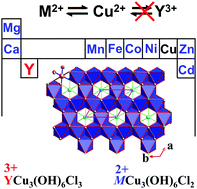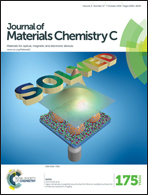Perfect Kagomé lattices in YCu3(OH)6Cl3: a new candidate for the quantum spin liquid state†
Abstract
Polymorphs of ZnCu3(OH)6Cl2 (herbertsmithite and kapellasite) and related cuprates MCu3(OH)6Cl2 (M = Mg2+, Ca2+, Cd2+, Co2+, Fe2+, Mn2+ and Ni2+) with antiferromagnetic Kagomé lattices have attracted attention for intensively investigating the quantum spin liquid (QSL) materials. However, mixing between magnetic (Cu2+) and diamagnetic divalent ions (Zn2+, Mg2+, etc.) is commonly significant in MCu3(OH)6Cl2 and therefore disturbs the perfect Kagomé lattices consequently adversely affecting the magnetic performance. Herein we report on the synthesis and characterization of YCu3(OH)6Cl3, the first-ever cuprate of the kapellasite-type structure with a trivalent cation. Single-crystal X-ray structure refinements show that the diamagnetic Y3+ cations in the title compound are located at the Zn positions and are charge balanced by additional Cl− anions between the Kagomé layers. 65Cu and 35Cl MAS NMR analyses confirm single-crystal X-ray diffraction data that there is no detectable mixing between Y3+ and Cu2+ in the title compound, resulting in a more idealized Kagomé lattice than those in herbertsmithite and kapellasite. Magnetic analyses demonstrate that the title compound is a geometrically frustrated S = 1/2 antiferromagnet with a Curie–Weiss temperature θ of −99 K and does not show any magnetic transition down to 2 K (i.e., the frustration parameter f > 49), suggesting a possible QSL candidate.



 Please wait while we load your content...
Please wait while we load your content...